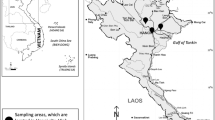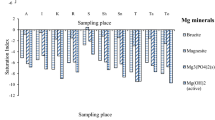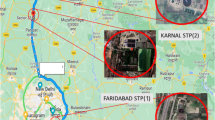Abstract
Little Akaki River is one of the major rivers flowing through Addis Ababa City and receives industrial, domestic, and municipal wastewaters constituting organic, nutrients, and trace metals. A sedimentation tank was established nearby the river to produce sludge from the polluted river water and use it as organic fertilizer. The objectives of the study were to investigate the mobility and bioavailability of heavy metals in the sludge and to evaluate the environmental risk and suitability of the sludge for agricultural land application. The concentration of trace metals in sludge was determined using inductively coupled plasma optical emission spectrophotometry and metals fractionations were done following modified community bureau of reference procedures. The results showed that the organic matter content of the sludge ranged from 43 to 57%. This study revealed that 39.17% of Zn; 19.22% of Cr; 30.23% of Cd, and 31.25% of Pb were found in readily bioavailable forms. The average mobility factor of all trace metals was 67%, indicating horizontal migration of trace metals in soil. The risk assessment code revealed that all trace metals fall in the medium to high environmental risk classes. The concentrations of trace metals in the analyzed sludge samples were below the standard limits of sewage sludge, indicating the suitability of the sludge for organic fertilizer. However, due to the high mobility, bioavailability, and environmental risks of trace metals, using the sludge as organic fertilizer on agricultural croplands may further escalating soil pollution, adversely affecting the environment and public health.




Similar content being viewed by others
Data availability
Data generated during the study are included in this published article.
References
Abdallah MAM (2017) Chemical speciation and contamination assessment of Pb and V by sequential extraction in surface sediment of Nile Delta, Egypt. Arab J Chem 10:68–75
Abdu N, Agbenin JO, Buerkert A (2012) Fractionation and mobility of cadmium and zinc in urban vegetable gardens of Kano, Northern Nigeria. Environ Monit Assess 184:2057–2066
Alemayehu TA, Sulaiman H, Hailu A (2011) Metal concentration in vegetables grown in the hydrothermally affected area in Ethiopia. J Geogr and Geol 3(1):86
Alemu NF, Changming Y, Yang Y (2020) Assessment of heavy metals concentration in agriculture soil of Kolfe area, Addis Ababa, Ethiopia. Int J Sci Res Publ. https://doi.org/10.29322/IJSRP.10.01.2020.p9716
Amir S, Hafidi M, Merlina G, Revel JC (2005) Sequential extraction of heavy metals during composting of sewage sludge. Chemosphere 59:801–881
Aschale M, Sileshi Y, Kelly-Quinn M, Hailu D (2016) Pollution assessment of toxic and potentially toxic elements in agricultural soils of the city Addis Ababa, Ethiopia. Bull Environ Contam Toxicol. https://doi.org/10.1007/s00128-016-1975-4
Cao L, Tian H, Yang J, Shi P, Lou Q, Ni Z, Peng X (2015) Multivariate analyses and evaluation of heavy metals by chemometric BCR sequential extraction method in surface sediments from Lingdingyang Bay, South China. Sustainability 7:4938–4951. https://doi.org/10.3390/su7054938
Dabrowska L (2016) Fractionation of heavy metals in bottom sediments and sewage sludge using sequential extraction. Ecol Chem Eng 23(1):63–75
Decree (1999) Use of sludge in agriculture of 11.08.1999, Dziennik Ustaw 99.72.813 of 31.08.1999
European Commission (2001) BCR Information reference materials, the certification of the extractable content (mass fractions) of Cd Cr Cu Ni Pb and Zn in freshwater sediment following a sequential extraction procedures, BCR-701, printed in Belgium
European Community (EC) (1998) Official Journal of the European Communities, Council Directive, on the protection of the environment, and in particular of the soil, when sewage sludge is used in agriculture, (86/278/EEC)
Fitamo D, Leta S, Belay G, Lemma B, Olsson M (2011) Phytoavailability of heavy metals and metalloids in soils irrigated with wastewater, Akaki, Ethiopia: a greenhouse study. Soil Sediment Contam 20:745–766. https://doi.org/10.1080/15320383.2011.609196
Förstner U (1993) Metal speciation—general concepts and applications. Int J Environ Anal Chem 51(1–4):5–23
Fu X, Zhong L, Jagannathan V, Fang W (2017) Sludge to energy: an environment-energy economic assessment of methane capture from sludge in xiangyang city, Hubei Province. Working paper. World Resources Institute, Washington, DC. Available online at http://www.wri.org/publication/environment-energy-economic-assessmentsludge-energy-approach
Guo-hang Y, Zhu G, He-lian L, Xue-mei H, Ju-mei L, Yi-bing MA (2018) Accumulation and bioavailability of heavy metals in a soil-wheat/ maize system with long-term sewage sludge amendments. J Integr Agric 17(8):1861–1870
Hacısalihoğlu S (2016) Karaer F (2016) Relationships of heavy metals in water and surface sediment with different chemical fractions in lake Uluabat, Turkey. Pol J Environ Stud 25(5):1937–1946. https://doi.org/10.15244/pjoes/62908
Hanay O, Hasar H, Kocer NN, Aslan S (2008) Evaluation for agricultural usage with speciation of heavy metals in a municipal sewage sludge. Bull Environ Contam Toxicol 81:42–46. https://doi.org/10.1007/s00128-008-9451-4
Harrison EZ, McBride MB, Bouldin DR (1999) Land application of sewage sludge: an appraisal of the US regulations. Int J Environ Pollut 11(1):1–36
Hei L, Jin P, Zhu X, Ye W, Yang Y (2016) Characteristics of speciation of heavy metals in municipal sewage sludge of Guangzhouas fertilizer. Procedia Environ Sci 31:232–240
Howladar M, Farhad A, Numanbakth MDA, Faruque MO (2017) An application of water quality index (WQI) and multivariate statistics to evaluate the water quality around the maddhapara mining industrial area, Dinajpur, Bangladesh. Environ Syt Res 6:13
Itanna F, Anderson D, Stahr K (2003) Influence of soil type differences on the distribution of DTPA extractable heavy metals in soils irrigated with industrial effluents. SINET Ethiop J Sci 26(1):47–54
Jain CK (2004) Metal fractionation study on bed sediments of River Yamuna, India. Water Res 38:569–578
Jakubus M, Czekala J (2001) Heavy metal speciation in sewage sludge. Pol J Environ Stud 10(4):245–250
Jakubus M (2020) Changes in lead and chromium contents in sewage sludge evaluated using both single extractants and sequential method. Environ Pollut Bioavailab 32(1):87–99
Juang DF, Chen P (2007) Treatment of polluted river water by a new constructed wetland. Int J Environ Sci Tech 4(4):481–488
Kiper J, Glowacka A, Rucinska T (2019) Analysis of the variability of the composition of sewage sludge before and after drying treatment. SEM Stud 20(7):45–52. https://doi.org/10.12911/22998993/109864
Klink A, Dambiec M, Polechonska L (2019) Trace metal speciation in sediments and bioaccumulation in Phragmites australis as tools in environmental pollution monitoring. Int J Environ Sci Technol 16:7611–7622
Lukowski A (2016) Fractionation of heavy metals (Pb, Cr, and Cd) in municipal sewage sludge from Podlasie Province. J Ecol Eng 18(1):132–138
Malwina T, Kamila W, Ewa Z (2016) Heavy metals and its chemical speciation in sewage sludge at different stages of processing. Environ Technol 37(7):899–908. https://doi.org/10.1080/09593330.2015.1090482
Mekuria DM, Kassegne AB, Asfaw SL (2021) Assessing pollution profiles along Little Akaki River receiving municipal and industrial wastewaters, Central Ethiopia: implications for environmental and public health safety. Heliyon 7:e0752
Melaku S, Wondimu T, Dams R, Moens L (2007) Pollution status of Tinishu Akaki River and its tributaries (Ethiopia) evaluated using physicochemical parameters, major ions, and nutrients. Bull Chem Soc Ethiop 21(1):13–22
Mi Y, Zhan F, Li B, Qin L, Wang J, Zuiand Y, Li Y (2015) Distribution characteristics of cadmium and lead in particle size fractions of farmland soils in a lead-zinc mine area in Southwest, China. Environ Syst Res 7:14. https://doi.org/10.1186/s40068-018-0117-x
Modaihsh AS, Al-Swailem MS, Mahjoub MO (2004) Heavy metals content of commercial inorganic fertilizers used in the Kingdom of Saudi Arabia. Agric Mar Sci 9(1):21–25
Nkinahamira F, Suanon F, Chi Q, Li Y, Huang X, Yu CP, Sun Q, Feng M (2019) Occurrence, geochemical fractionation, and environmental risk assessment of major and trace elements in sewage sludge. J Environ Manag 249:109427
Oketola AA, Adekolurejo SM, Osibanjo O (2013) Water quality assessment of river Ogun using multivariate statistical techniques. J Environ Prot 4:466–479. https://doi.org/10.4236/jep.2013.45055
Ouyang Y (2005) Evaluation of river water quality monitoring stations by principal component analysis. Water Res 39:2621–2635
Peruzzi E, Masciandaro G, Macci C, Doni S, Ravelo S, Peruzzi P, Ceccanti B (2011) Heavy metal fractionation and organic matter stabilization in sewage sludge treatment wetlands. Ecol Eng 37:771–778
Poykio R, Watkins G, Dahl O (2019) Characterization of municipal sewage sludge as a soil improver and a fertilizer product. Ecol Chem Engs 26(3):547–557. https://doi.org/10.1515/eces-2019-0040
Rumhayati B, Retnaningdyah C (2018) Integrative assessment of Pb and Cd pollution in Porong Estuaries using sediment chemistry, bioavailability, and bioconcentration factor. Indones J Chem 18(3):464–471
Sullivan ADO, Moran BM, Otte ML (2004) Accumulation and fate of contaminants (Zn, Pb, Fe, and S) in substrates of wetlands constructed for treating mine wastewater. Water Air Soil Pollut 157:345–364
Tamiru A (2006) Heavy metal concentration in the Urban environment of Addis Ababa, Ethiopia. Soil Sediment Contam Int J 15(6):591–602. https://doi.org/10.1080/15320380600959081
Tokalioglus E, Karta SEL, Gultek AF (2006) Investigation of heavy metal uptake by vegetables growing in contaminated soils using the modified BCR sequential extraction method. Int J Environ Anal Chem 86(6):417–430
Turek A, Wieczorek K, Wolf WM (2019) Digestion procedure and determination of heavy metals in sewage sludge—an analytical problem. Sustainability 11:1753. https://doi.org/10.3390/su11061753
Tytla M, Widziewicz K, Zielewicz E (2016) Heavy metals and its chemical speciation in sewage sludge at different stages of processing. Environ Technol 37(7):899–908
US EPA (1993) The Standards for the use or disposal of sewage sludge, title 40 of the Code of Federal Regulations, Part 503
US EPA (1994) Land application of sewage sludge a guide for land appliers on the requirements of the Federal Standards for the use or disposal of sewage sludge, 40 CFR Part 503, EPA/831-B-93-002b, Washington, DC 20460
Usharani B, Vasudevan N (2016) Eco-friendly approach for leaching out heavy metals from sewage sludge. Chem Ecol 32(6):507–519
Yang K, Zhang T, Shao Y, Tian C, Cattle SR, Song J (2018) Fractionation, bio-accessibility, and risk assessment of heavy metals in the soil of an urban recreational area amended with composted sewage sludge. Int J Environ Res Public Health 15:613
Acknowledgements
The authors would like to acknowledge Addis Ababa University for funding this research works through its thematic research support program (Project No. TR/012/2016 and RD/PY-609/2016).
Author information
Authors and Affiliations
Contributions
DMM has contributed to the study conception and design, materials preparation, involved in data collection and analysis, writing the drafting of the manuscript. AB has contributed to the study conception and design, materials preparation, participated in data collection and analysis, editing the manuscript. SLA has contributed to the study conception and design, materials preparation, involved in data collection and analysis, fund acquisition, supervision, and editing of the manuscript.
Corresponding author
Ethics declarations
Conflict of interest
The authors declared that they have no conflict of interest.
Additional information
Editorial responsibility: Rangabhashiyam S.
Rights and permissions
About this article
Cite this article
Mamo Mekuria, D., Berhanu Kassegne, A. & Leta Asfaw, S. Suitability analysis, bioavailability, and mobility of heavy metals in the sludge produced from polluted river water, Central Ethiopia. Int. J. Environ. Sci. Technol. 19, 8811–8824 (2022). https://doi.org/10.1007/s13762-021-03744-x
Received:
Revised:
Accepted:
Published:
Issue Date:
DOI: https://doi.org/10.1007/s13762-021-03744-x




